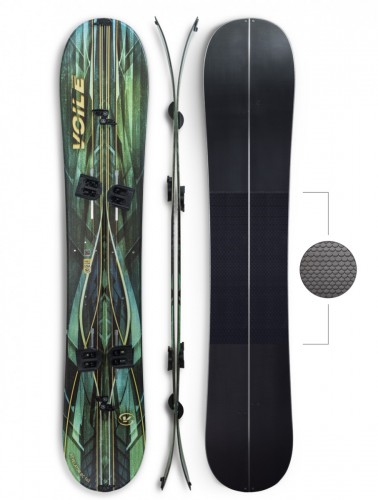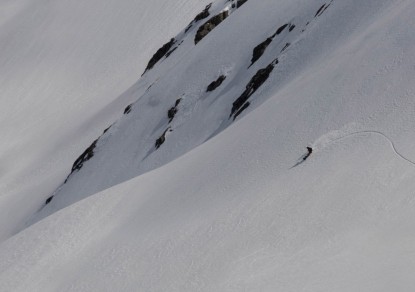The Revelator BC is the splitboard version of the Voile Revelator. The base of this board has XC-style fish scales, which the manufacturer calls their "Voile Traction-Pattern Base." It's not a far cry from the textured design seen at the base of cross-country skis. The patterned section runs between the binding area.
Voile tweaked the graphics for the Revelator BC, but the board otherwise remains the same as the version we tested. The latest graphics are pictured above.
November 2019With this split, we were able to ascend soft snow as long as we kept the approach angle quite low. It is cool to cruise around without skins but with enough traction to make forward progress. On a slick skin track, this splitboard quickly met its match and needed to either chart a less steep track or throw on the skins. That said, the patterned base is much faster than skins climbing on flat or low-angle rolling terrain; the patterned base also descends much more quickly than skins do, which was helpful when we descended a local peak onto a large flat lake. We just transitioned to ski mode and relied on the patterned base to cross the flats. Skipping the skins saved us a minute or so of transition.
The downside with this model was that the patterned base makes the board noticeably slower when descending. On steep terrain this is not much of an issue, but when angles mellow and you are trying to maximize speed, the extra friction is significant. We found the friction to be an issue both in snowboard and ski mode. This is especially noticeable when in a group where only one person has the splitboard (in this case, this particular model) with the patterned base and everyone else has a normal smooth base. When exiting one particular low-angle fire road, the base reduced glide enough and it appeared to be a net negative in that the extra distance that would have been covered (by having a smooth base) was not made up by the benefit of the patterned base on the few small flat sections.
Best Applications
Conclusion
The general performance of this model closely follows the regular model, but with some extra wrinkles because of the patterned base. In certain snow conditions, we could audibly hear the patterned base moving across the snow surface. The only significant benefit we found was on mellow approaches or exits. We were concerned that the patterned base would be difficult for skins to stick to, but this was not a problem in our testing. The patterned base is only between the bindings, while most skin issues start at the tip and tail.







